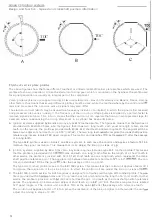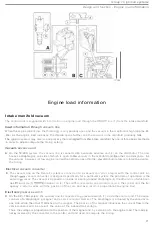
Group
2
8
Ig
n
i
r
ion sys
r
ems
Design and function
Compensa
t
ion
functions
Knock
'
threshold
'
Under
certain
condi
t
ions,
however,
the
combination
of high perlormance and
lo
w
fuel
con
sumption
demands
that
the engine runs as
close
as possible
t
o
the knock
threshold
.
The
closer
the
curve
to the threshold
,
Ihe
higher
the
efficiency of
fuel
utilization.
In
other
words
.
the
knock
threshold
is
not
a
fixed limit, but varies depending on
run
-
n
i
ng
conditions.
Methods of preventing
knock
Knock may be prevented
by
retarding the
ignition. Since
detonation
of
the mixtu
r
e occurs
when the piston
is
closer
t
o TOC, the pressure and temperature
in
the
cylinder
are
t
hereby
lowered, reducing the
r
is
k
of
detonation
.
Knock
is
also p
r
evented by enriching the mixture, which has t
h
e effect
of reducing
the
combus
t
io
n t
em
p
e
r
ature
.
• Knock
may
be
caused by the
fo
llo
wing
:
Use
of a
fuel with
an octane
rat
in
g
is
too
low for t
he
compression
rat
io
of
Ihe
engine
.
fue
l/ai
r
ratio
.
mixture
is
too
lean,the
temperature
In the combustion
chamber
be
h
igh
despite a conslant com·
pression ratio. A
lean
may
be
due
10
a
such as tow fuel pressure or
lea
ka
ge into
the
induction system.
-
high
combustion
temperature.
Carbon
deposits
in
Ihe
combustion chamber
the rate
of
heat dissipation,
resulting in high
temperature
cre
at
ing
the risk
of
glow
IgnitIon)
.
DefiCient
cooling (due,
for
example,
to
a
water
pump,
radiator or
thermostat
,
or
to
deposits
the
cooling
passages). Will have the
-
Incorrect or worn
spark
plugs
.
The fisk of detonation
be
greatly mcreased if the plug IS
o
f
the wrong
if
the
heat
rating
is
or is it IS
fouled
.
timing. The resistance to
knock Will be
im
pa
ired
if
ignition
take
s
place
too
early. since the cylinder
pressure
and tem-
w
ill
be
higher
under
these conditions.
-
A
sudden
i
nc
r
ease
in engine speed.
What
is
known
as 'transitional"
kno
c
k w
ill
occur if the engine speed
and
l
oad
are
suddenly in·
creased.
If the engine
running under normal
con
ditions
of speed and
load
{with the
timing fairly weI!
advanced),
sudden de
-
p
r
ession of
the accelerator will produce
an
ins
tantaneous increase
in
the quantity of mixture admitted
before the
system
has had
time to
adjust
the t
iming
accordingly.
For
a brief period,
therefore.
the timing
will be too
advanced
for the amount
of mixture
i
n
the
of the
fun
c
t
ions
with which
the control unit
is
programmed limits
the
scope of
timing
adjustment
to
a
number of
degrees
per
cran
kshaft
29
















































